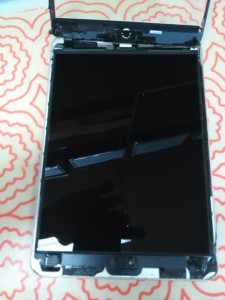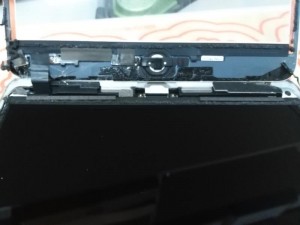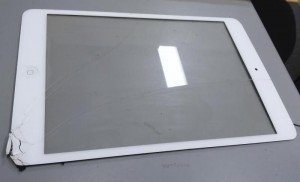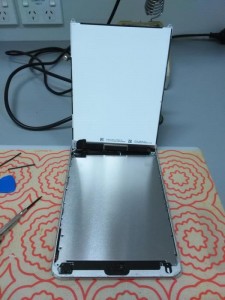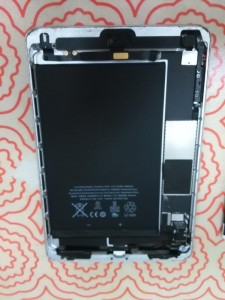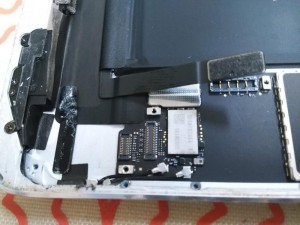These are some of the steps involved in completing an Apple iPad Mini 2nd generation screen repair. Note that often it is not the LCD screen that is cracked, but the Gorilla glass digitizer that sits on top responsible for providing touch functionality to the device.
Partial removal of the digitizer overlay module using a heatgun on low heat as the module is glued in place.
Close up view of digitizer module. Note the flatribbon connector cable in the corner of the digitizer module and the tape covering parts adjacent to the home button. Note the two strips of tape on the LCD screen acting as a hinge.
Cracked digitizer module removed.
LCD screen hinged upwards exposing the aluminum tray.
LCD screen and aluminum tray removed.
Apple iPad mini 2nd generation and LCD screen side by side. This device had suffered accidental damage where it was dropped onto the floor causing the screen to crack. Note the rounded corners of the device have all been returned to their original shape to ensure a good fit of the replacement screen (digitizer).
Close-up view of digitizer module connector, LCD screen connector and battery connector.
Common mistakes (iPad Mini)
Shutdown the device properly first
When you press the wake/sleep button in the top right corner of the iPad, the device remains powered. The wake/sleep button is not an on/off button as such. You need to hold the wake/sleep button for a few seconds and then confirm you want to power off the device.
Disconnect the battery before disconnecting the LCD display connector
If you remove the LCD display connector whilst the battery is still connected, you almost certainly will blow a fuse. This fuse protects the sensitive electronics in the LCD display from power surges. It is easier and cheaper to replace a fuse than to replace a costly LCD screen. Replacing the extremely small surface mounted fuse requires specialized skills in handling and soldering. This fuse is located on the iPad internally and will be damaged when the LCD display is disconnected from the device. This is the number #1 cause of failed screen repair jobs.
Cheap and low quality aftermarket digitizers
There are a lot of low-quality aftermarket digitizers available for sale on the internet. The original digitizer has copper colored metal strips on the back, not silver colored metal strips. The original digitizer is made of Gorilla glass, a of specialized toughened glass designed to be thin, light and damage-resistant. When ordering a replacement digitizer make sure the correct connector is included as well as good quality replacement adhesive strips.
Magnets
Don’t forget to put back the magnets – these are used to attract the magnets in the flap of your smart cover to keep the flap closed.
Home button
Don’t forget to transfer the black tape masking the exposed metal contacts on the Home button.

